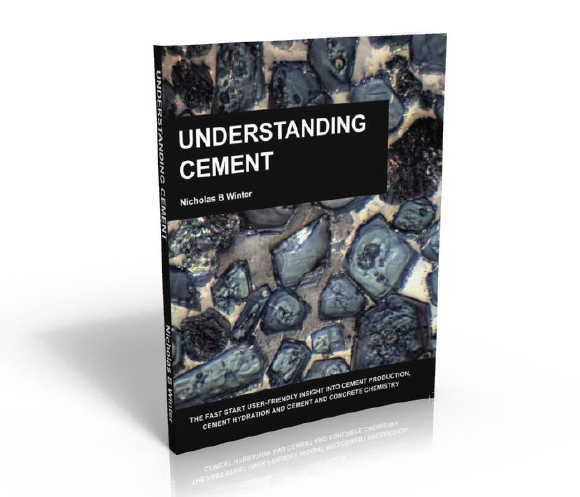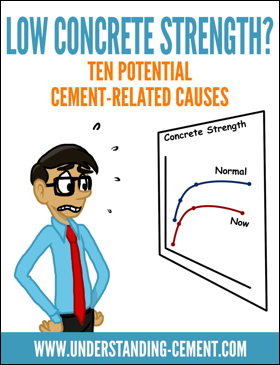Clinker: reactions in the kiln
The milled and blended raw materials go to a silo and then to the kiln. Reactions which take place as the feed passes through the kiln are reviewed below.
They can be considered under three broad headings:
- Decomposition of raw materials - temperatures up to about 1300 °C.
- Alite formation and other reactions at 1300 C-1450 °C in the burning zone.
- Cooling of the clinker.
Decomposition of raw materials - reactions at temperatures up to about 1300 °C
This includes:
- Water evaporation in the raw feed, if any.
- Loss of carbon dioxide from the limestone (ie: calcining).
- Decomposition of the siliceous and aluminosilicate fractions of the feed.
- Formation of a sulfate melt phase.
The decomposition products react with lime to form intermediate compounds which in turn form other compounds as clinkering proceeds.
Water evaporation
In wet-process kilns, and their derivatives, water must first be driven off. In a wet-process kiln, calcining takes place after the water has been driven off, about a third of the way down the kiln. In the more modern pre-calciner kilns, the feed is calcined prior to entering the kiln.
Calcining
In isolation, decarbonation of calcium carbonate at 1 atmosphere takes place at 894 °C. This temperature is reduced to 500 °C - 600 °C if the reaction takes place in contact with quartz or the decomposition products of clay minerals, which react with the calcium oxide as it forms.
In a wet-process or preheater system without a pre-calciner, most of the calcination takes place in the rotary kiln within a moving mass of feed. This situation is not ideal for calcination because heat transfer has to take place through a large mass of material and CO2 has to escape outwards as heat moves inwards.
A pre-calciner calcines the raw
material much more efficiently than a wet-process kiln. Raw meal is
dispersed in the hot gas and calcination takes place in seconds, rather
than the half an hour or so inside a kiln at the same temperature.
Formation of early and intermediate compounds
During
calcination, the lime produced starts to react with other components of
the raw feed. The initial silicate product is belite. Some calcium
aluminate and ferrite phases also start to form.
A number of
phases are formed in the clinker feed before the burning zone proper is
reached. These intermediate phases dissociate in the burning zone and
are not therefore found in clinker but assist in forming the final
clinker minerals.
Sulfate melt phase
At
intermediate temperatures, sulfates combined with calcium and alkalis
form a liquid phase. This is separate from the aluminate and
aluminoferrite-based liquid formed in the burning zone - the two liquids
are immiscible.
As with the main liquid phase, the sulfate liquid phase contributes to ion mobility and promotes combination.
Alite formation and other reactions at
1300 °C - 1450 °C in the burning zone
In the burning zone, above about 1300 °C, reactions take place quickly. The clinker is in the burning zone for perhaps 10-20 minutes but in this time a lot happens:
- The proportion of clinker liquid increases and nodules form.
- Intermediate phases dissociate to form liquid and belite.
- Belite reacts with free lime to form alite.
- Some volatile phases evaporate.
Clinker liquid and nodule formation
Above about 1300 °C the proportion of liquid starts to increase - by 1450 °C, perhaps 20-30% of the mix is liquid. The liquid forms from melting ferrite and aluminate phases and some belite. The liquid content is more than the sum of the aluminate and ferrite phases in the cooled clinker because of the dissolved lime and silica.
The additional liquid causes coalescence of clinker particles, leading to the formation of nodules.
Dissociation of intermediate phases
The intermediate phases dissociate to form mainly belite and liquid.
Alite formation
Alite forms by the transition of some of the belite to alite and also directly from free lime and silica to alite. This occurs rapidly once the clinker temperature is above about 1400 °C.
Evaporation of volatiles
Volatile phases in the cement kiln are principally alkali sulfates, with a much smaller proportion of alkali chlorides. As the part-burned feed approaches the burning zone, these volatile phases are in liquid form and a proportion volatilizes, the remainder passing out of the kiln in the clinker as inclusions within the pores.
The volatilized material passes back down the kiln, where it condenses on the relatively cool incoming feed. It again becomes part of the sulfate melt phase, promoting reactions, and is once again carried within the clinker towards the burning zone.
This recirculating load of alkali and sulfate can occasionally become excessively high. Large quantities of condensing volatiles can then cause blockages in the kiln or in the preheater as the condensed liquid sticks feed particles together, forming accretions.
Cooling of the clinker
As the clinker cools, the main liquid phase crystallizes to form aluminate phase, ferrite and a little belite.
Fast cooling of clinker is advantageous - it makes for more hydraulically-reactive silicates and lots of small, intergrown, aluminate and ferrite crystals.
Slow cooling gives less hydraulically-reactive silicates and produces coarse crystals of aluminate and ferrite. Over-large aluminate crystals can lead to erratic cement setting characteristics. Very slow cooling allows alite to decompose to belite and free lime.
Get a Better Understanding of Cement
Articles like this one can provide a lot of useful material. However, reading an article or two is perhaps not the best way to get a clear picture of a complex process like cement production. To get a more complete and integrated understanding of how cement is made, do have a look at the Understanding Cement book or ebook. This easy-to-read and concise book also contains much more detail on concrete chemistry and deleterious processes in concrete compared with the website.
Click here for more information
You are in Reactions in the kiln:
The following pages have more details on clinker composition, reactions in the kiln and cement milling:
Cement notation
/
Clinker compositional parameters
/
Bogue calculation
/Combinability
/
Cement milling
Check the Article Directory for more articles on this or related topics

